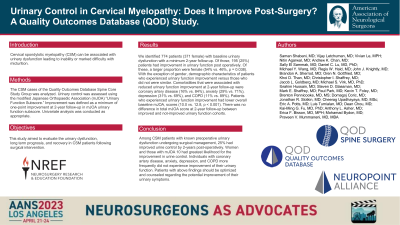Urinary Control in Cervical Myelopathy: Does It Improve Post-Surgery? A Quality Outcomes Database (QOD) Study
Urinary Control in Cervical Myelopathy: Does It Improve Post-surgery? A Quality Outcomes Database (QOD) Study
Friday, April 21, 2023


Saman Shabani, MD
Neurosurgery Faculty
University of Wisconsin
San Francisco, California, United States
ePoster Presenter(s)
Introduction: Cervical spondylotic myelopathy (CSM) can be associated with urinary dysfunction leading to inability or marked difficulty with micturition. This study aimed to evaluate the urinary dysfunction, long-term prognosis, and recovery in CSM patients following surgical intervention.
Methods: The CSM cases of the Quality Outcomes Database Spine Core Study Group were analyzed. Urinary control was assessed using the modified Japanese Orthopaedic Association (mJOA) “Urinary Function Subscore.” Improvement was defined as a minimum of one-point improvement at 2-year follow-up in mJOA urinary function subscore. Univariate analysis was conducted as appropriate.
Results: We identified 774 patients (371 female) with baseline urinary dysfunction with a minimum 2-year follow-up. Of those, 195 (25%) patients had improvement in urinary function postoperatively. Of these, a larger proportion were female (54% vs. 46%, p = 0.038). With the exception of gender, demographic characteristics of patients who experienced urinary function improvement versus those who did not were similar. Comorbidities that were associated with reduced urinary function improvement at 2-year follow-up were coronary artery disease (16% vs. 84%), anxiety (29% vs. 71%), depression (31% vs. 69%), and COPD (11% vs. 89%). Patients who experienced urinary function improvement had lower overall baseline mJOA scores (10.0 vs. 12.8, p < 0.001). There was no difference in total mJOA score at 2-year follow-up between improved and not-improved urinary function cohorts.
Conclusion : Among CSM patients with known preoperative urinary dysfunction undergoing surgical management, 25% had improved urine control by 2-years post-operatively. Women and those with mJOA 10 had greatest likelihood for the improvement in urine control. Individuals with coronary artery disease, anxiety, depression, and COPD more frequently did not experience improvement of their urinary function. Patients with above findings should be optimized and counseled regarding the potential improvement of their urinary symptoms.
Methods: The CSM cases of the Quality Outcomes Database Spine Core Study Group were analyzed. Urinary control was assessed using the modified Japanese Orthopaedic Association (mJOA) “Urinary Function Subscore.” Improvement was defined as a minimum of one-point improvement at 2-year follow-up in mJOA urinary function subscore. Univariate analysis was conducted as appropriate.
Results: We identified 774 patients (371 female) with baseline urinary dysfunction with a minimum 2-year follow-up. Of those, 195 (25%) patients had improvement in urinary function postoperatively. Of these, a larger proportion were female (54% vs. 46%, p = 0.038). With the exception of gender, demographic characteristics of patients who experienced urinary function improvement versus those who did not were similar. Comorbidities that were associated with reduced urinary function improvement at 2-year follow-up were coronary artery disease (16% vs. 84%), anxiety (29% vs. 71%), depression (31% vs. 69%), and COPD (11% vs. 89%). Patients who experienced urinary function improvement had lower overall baseline mJOA scores (10.0 vs. 12.8, p < 0.001). There was no difference in total mJOA score at 2-year follow-up between improved and not-improved urinary function cohorts.
Conclusion : Among CSM patients with known preoperative urinary dysfunction undergoing surgical management, 25% had improved urine control by 2-years post-operatively. Women and those with mJOA 10 had greatest likelihood for the improvement in urine control. Individuals with coronary artery disease, anxiety, depression, and COPD more frequently did not experience improvement of their urinary function. Patients with above findings should be optimized and counseled regarding the potential improvement of their urinary symptoms.
